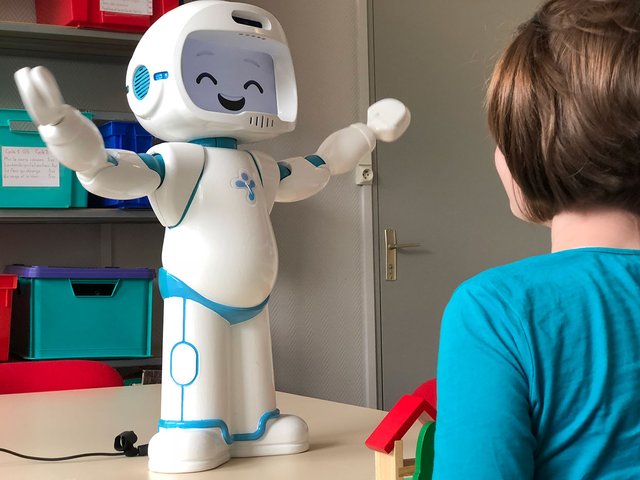Robots help autistic children development
A good news... Congrats !!!

Robots designed to help children with Autism Spectrum Disorders learn may be useful for the overall development of these children, a new study finds. Contrary to expectations, children do not "lose" their relationship with other relatives, but on the contrary - become more attached to all of their family. Psychologists are surprised and hope that this type of robot will soon be more accessible to kids around the world.
About 1 in every 160 children worldwide has an autism spectrum disorder. Leaving aside the issue of reducing the causes of these types of health problems, the challenge remains to support those who already have this disorder. Their slow development is often characterized by social, emotional and communication difficulties. Such children need intensive care and many, many daily work with them to improve their development.
A promising new way for personalized care
Psychologists usually work with such children. It costs a lot of time and effort and is expensive, according to a MIT Technology Review post. There may also be a shortage of specialists because every child needs to work with him at least 20 hours each week.
Fortunately, the advancement of social support robots in recent years has been a promising new way for autistic patients to receive more accessible and personalized care. In theory, home robots can help complement the work of therapists. They can “engage” in more repetitive training activities, and artificial reason can help individualize the approach.
Advances in artificial intelligence
A new analysis published in Science Robotics reveals an important step in the advancement of AI that underpins these home assistants. Maya. J. Mataric and her team at the University of Southern California have created a machine learning model that uses audio and video data (such as dialogue and eye contact) to communicate autistic children with robots to predict whether children are engaged in a training activity.
The idea is that if the children are not engaged, the robot can react and do what it takes to engage them again so that they keep their attention on therapeutic exercises for a longer period of time. In testing, the model reached 90% accuracy in predicting child involvement. This was achieved despite the noise in the data and the high variability among the participants.
The study was done using data collected by robots who "lived" with their children in their homes for a month. The project is part of a multi-year research initiative that seeks to explore the impact of these assistants in a real-world setting and improve their "skills".
The one-month period is essential. Most of the studies to date have been limited to short time intervals, which creates insufficient basis for conclusions.
Mastering basic social skills
The study participants were asked to regularly play space-themed math games using a touchscreen tablet attached to the corresponding robot assistant. The robot then gave detailed feedback based on the performance and the type of game customized to the individual through an algorithm to refine the training.
Although the content of the game was focused on mathematics, in fact the primary purpose of the robots was to teach children basic social skills through interactions with machines, such as ordering (is my turn now or is it your turn?) And eye contact. For each intervention, a behavioral therapist evaluated each child's social skills - before and after the program - validating the approach to improving them.
"Kids need to learn in a social setting," Mataric says. "But there is not enough practice for children with autism with this. That's why the robot is important. " Many children over time have learned to deal with the robot as a friend and have improved their sense of empathy for their peers.
Improving family relationships
Many also enrolled the robot in their family social circles and became more involved with their siblings and parents, reaffirming the scientists' assumption that robots could improve, instead of replace, existing family relationships.
The internal environment was more challenging than the researchers initially expected. Participants sometimes accidentally damaged the robot or moved its camera, which means inconsistency and "noise" in the data collected. Often, siblings of children with autism also want to play special games, which complicates the analysis later.
"The project helps to demonstrate the positive impact of using social-interactive robots in working with children with special needs," said Ayana Howard, a professor at Georgia Tech who also studies the therapeutic effects of robots on children with autism. She and Mataric hope that such robots with the function of social assistants will become available so that children with autism can receive more comprehensive care and improve their development.
The Steem blockchain is currently being attacked by a central authority in order to take control of the witnesses. If you are not managing your witness votes, please consider setting @berniesanders as your witness voting proxy by clicking here to help restore the decentralization of Steem.
Hi @dappuser
Solid read buddy. I've noticed that you do not engage much with others in comments section, so let me just show my support with little upvote only.
@tipu curate
Upvoted 👌 (Mana: 5/20 - need recharge?)